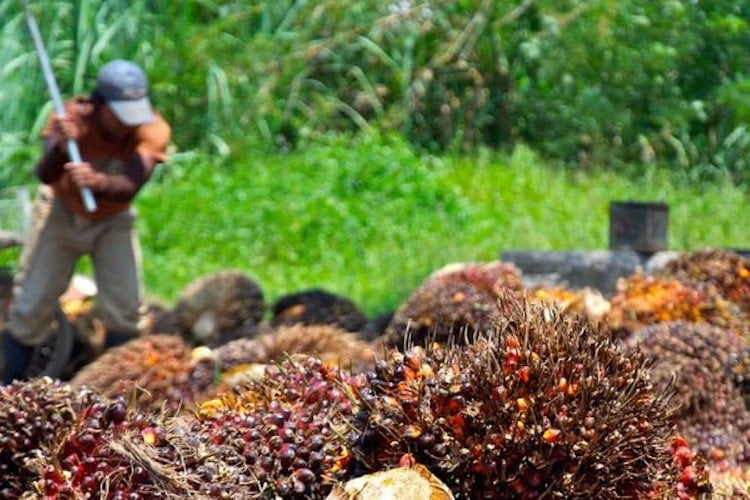
Natasha Longo, Prevent Disease
Palm oil of any kind, whether it be from the fruit or kernel is not beneficial to the Earth or human health. The marketing gurus behind the largest palm oil manufacturers in the world will never give you the whole story. In fact, they are attempting to deceive international governments at every turn with false information and misrepresented data. Palm fruit oil or palm kernel oils are not healthy at all and most of the health risks are associated with the processing of which very few have been informed.
The use of palm oil has skyrocketed in recent years, and at 50 million metric tons in 2010, it is the most heavily utilized vegetable oil. While consumers in India, China, and Indonesia directly buy raw palm oil for cooking and frying, in developed markets many are unaware that palm oil is used in approximately half of all packaged foods, personal care, and cleaning products.
Palm oil’s dramatic growth has occurred for good reason. The oil palm is currently the most efficient vegetable oil crop in the world. While one hectare of land can produce just 0.38 tons per year of soybean oil, 0.48 tons of sunflower oil, and 0.67 tons of rapeseed oil, that same hectare can produce more than 3.7 tons of palm oil.
High yields and low land requirements, then, make palm oil the least expensive vegetable oil in the market. Palm oil is also versatile, as it is readily usable for baking, frying, soaps, cosmetics, and biofuel. In contrast, most other vegetable oils require hydrogenation for some food uses.
Note that palm fruit oil and palm kernel oil are completely different oils with vastly different nutritional profiles. Palm fruit oil is often claimed to be highly nutritious and contains about equal amounts of saturated and unsaturated oils. Palm kernel oil is made from the kernel, or seed of the palm fruit and contains much higher amounts of saturated fat. Both are problematic for our health primarily due to processing. However, sustainability is also a major problem. Here are the 3 reasons you should stay away from any type of palm oil.
#1) Sustainability
Due to the massive worldwide backlash regarding the destruction of tropical ecosystems, every major palm oil company is now using the word “sustainable” to try and greenwash their ravaging of rain forests.
Unilever: “Through our Sustainable Agriculture Programme, we have been working towards the sustainable cultivation of oil palms for more than ten years.”
Kellogg: “…all of the palm oil we use today is 100 percent sustainablysourced through a combination of GreenPalm certificates, mass balance and segregated, sustainably grown supply.”
Nestle: “…committed to traceable sustainable palm oil….by end 2012, we will achieve a total of 80% RSPO certified sustainable palm oil.”
And the list goes on through several other manufacturers who use the world “sustainable” as if it’s going out of style.
The Roundtable for Sustainable Palm Oil was created to address huge issues of deforestation, land grabs and global warming in 2004. But the problem is, it was created by the largest palm oil producers and was supposed to set a global standard and certificate for palm oil that was grown sustainably. That’s like getting criminals involved in police procedure to set standards on catching criminals.
The most hospitable climates are situated within 20 degrees of the equator, the same region where tropical rain forests flourish and carbon-rich peatlands abound. Indonesia and Malaysia alone comprise more than 10 percent of the world’s remaining tropical rain forests, yet some predict that if current trends continue, Indonesia’s surviving rain forests will almost entirely disappear by 2022. Deforestation is especially noticeable on Borneo, an island more than twice the size of Germany.
In addition to deforestation, oil palm expansion has resulted in land use disputes with indigenous populations, frequently pitting plantation owners holding government concessions against native inhabitants with traditional land tenure. And if palm oil consumption continues to grow, as much as 15 million additional hectares of land, equivalent to five times the size of Belgium, will be needed by 2050–and that’s assuming that the use of palm oil as biodiesel feedstock doesn’t take off as a result of favorable regulations in the European Union and elsewhere.
At least half of the world’s wild orangutans have disappeared in the last 20 years; biologically viable populations of orangutans have been radically reduced in size and number; and 80 percent of the orangutan habitat has either been depopulated or totally destroyed. The trend shows no sign of abating: government maps of future planned land use show more of the same, on an increasing scale.
In Malaysia, peat swamp forests are being obliterated, and the disappearing forests endangering the habitat of the “pygmy elephant — the smallest elephant on Earth — the clouded leopard, the long-nosed tapir and many rare birds.”
As word spreads about the devastation that palm oil cultivation can cause, people are beginning to take notice and companies are beginning to make changes. Sustainable palm oil is in its infancy, and according toWorldwatch Institute, palm oil sustainability criteria remain controversial.
Check out saynotopalmoil.com to get a full perspective on what’s happening throughout the world because of palm oil.
But let’s set aside the issue of sustainability and let’s talk about health.
#2) Detrimental Health Effects
The palm fruit oil and palm kernel oil are high in saturated fatty acids, about 50% and 80% respectively and esterified with glycerol. The Oil palm gives its name to the saturated fatty acid palmitic acid of which it contains 44% by composition. According to the World Health Organization, evidence is “convincing” that consumption of palmitic acid increases risk of developing cardiovascular diseases, placing it in the same evidence category as trans fatty acids.
According to a report in The Journal of Clinical Investigation, rats fed a diet of 20% palmitic acid and 80% carbohydrate for extended periods showed alterations in central nervous system (CNS) control of insulin secretion, and suppression of the body’s natural appetite-suppressing signals from leptin and insulin (the key hormones involved in weight regulation). The results found that many of the deleterious effects of high-fat diets, specifically those enriched with palmitic acid, are CNS mediated resulting in reduced insulin activity. CNS resistance to leptin and insulin compromises the ability of both hormones to regulate food intake and body weight in the presence of diets high in saturated fat/palmitic acid, subsequently resulting in obesity.
Two meta-analysis have examined the effect of palmitic acid on serum cholesterol. In a 1997 study based on 134 clinical studies, British researchers concluded that, compared to carbohydrates, palmitic acid raises blood cholesterol levels (Clarke et al. 1997). In 2003, Dutch scientists conducted a meta-analysis of 35 clinical studies (Mensink et l. 2003) and examined what many experts consider the best indicator of heart-disease risk: the ratio of total cholesterol to HDL cholesterol Institute of Medicine, National Academies 2002). Palmitic acid increased the ratio of total cholesterol to HDL cholesterol more than other saturated fatty acids, including lauric acid and myristic acid, which are abundant in palm kernel oil. Palm oil increases the ratio of total cholesterol to HDL cholesterol more than the average U.S. or British dietary fat (Jensen et al. 1999; Keys et al. 1957). That finding indicates that, in terms of blood cholesterol, palm oil is somewhat more harmful than the average U.S. dietary fat and much more harmful than other oils such as olive and even soy and canola which are themselves toxic.
In a study published in a 1999 issue of “Plant Foods for Human Nutrition,” three Nigerian biochemistry researchers extol some of the nutrients found in fresh palm oil, but point out that the oil in an oxidized state can threaten physiological and biochemical functions of the body. They acknowledge that manufacturers of processed foods oxidize palm oil in their products for a variety of culinary purposes, meaning that much of the palm oil consumers eat is in an oxidized state. The dangers of oxidized palm oil include organotoxicity of the heart, kidney, liver and lungs, as well as reproductive toxicity, the researchers claim. Additionally, they note, oxidized palm oil can cause an increase in free fatty acids, phospholipids and cerebrosides.
The problem with palm fruit oil is not so much its saturated fat content because we know coconut oil has plenty of that and it’s one of the healthiest oils on Earth. However, coconut oil does not suppress the body’s natural appetite-suppressing signals from leptin and insulin. It is the triglyceride structure in palm oil which creates potentially negative health effects in contrast to coconut oil whose structure actually promotes health. Coconut oil also contains much higher amounts of myristic, lauric, and capric acid which are relatively absent in palm oil. Although coconut oil also contains palmitic acid, the ratio is much lower (about 9 times lower) and coconut oil’s saturated fat profile is much more balanced than palm oil. The health promoting effects of coconut oil exceed palm oil’s by a very large margin.
#3) Processing
Even the best palm oils go through extending heating and processing making them inferior to healthful oils such as virgin coconut or ice-pressed olive oils.
Virgin coconut oil is derived from the milk obtained from fresh coconut meat, and not necessarily from copra, by processes like fermentation, centrifugal separation and enzyme action, although some coconut oils can also be extracted using these methods from the kernel or meat. Care is taken to use no or as less heat as possible in the extraction of this oil. Produced this way, this oil tastes and smells the best and is laden with antioxidants and medium chain fatty Acids. It also has remarkable anti-microbial properties. Organic coconut oils are extracted from coconuts obtained from coconut palms raised only on organic manure and no synthetic fertilizers, insecticides etc., and without the involvement of any chemical in its extraction or processing.
Palm oil on the other hand whether refined, pure, organic or virgin, goes through extensive processing. Most small-scale palm oil processors do not have the capacity to generate steam for sterilization. Therefore, the threshed fruits are cooked in water. Whole bunches which include spikelets absorb a lot of water in the cooking process. Large scale operations use high-pressure steam heats the fruit at higher temperatures without losing as much water. Therefore, most small-scale operations thresh bunches before the fruits are cooked, while high-pressure sterilization systems thresh bunches after heating to loosen the fruits.
Sterilization or cooking means the use of high-temperature wet-heat treatment of loose fruit. Cooking normally uses hot water; sterilization uses pressurized steam. The heat treatment destroys enzymes and arrests hydrolysis and autoxidation, essentially changing the nutritional value of the fruit’s constituents from their natural state.
Heat solidifies the proteins in which the oil-bearing cells are microscopically dispersed. Only through high heat mechanisms is it possible to partially disrupt the oil-containing cells in the mesocarp and permit oil to be readily released.
The moisture introduced by the steam acts chemically to break down gums and resins. The gums and resins cause the oil to foam during frying. Starches present in the fruit are hydrolyzed and removed.
Once the oils has been pressed it must go through clarification and drying. The main point of clarification is to separate the oil from its entrained impurities.
The fluid coming out of the press is a mixture of palm oil, water, cell debris, fibrous material and ‘non-oily solids’. Hot water is therefore added to the press output mixture to thin it. The diluted mixture is passed through a screen to remove coarse fibre. The screened mixture is boiled from one or two hours and then allowed to settle by gravity in the large tank so that the palm oil, being lighter than water, will separate and rise to the top. To prevent increasing FFA through autocatalytic hydrolysis of the oil, the moisture content of the oil must be reduced to 0.15 to 0.25 percent.
Re-heating the decanted oil in a cooking pot and carefully skimming off the dried oil from any engrained dirt removes any residual moisture.
In large-scale mills the purified and dried oil is transferred to a tank for storage prior to dispatch from the mill. Since the rate of oxidation of the oil increases with the temperature of storage the oil is normally maintained around 50C, using hot water or low-pressure steam-heating coils, to prevent solidification and fractionation. Iron contamination from the storage tank may occur if the tank is not lined with a suitable protective coating.
Small-scale mills simply pack the dried oil in used petroleum oil drums or plastic drums and store the drums at ambient temperature.
The boiling/sterilizing and oil purification processing of palm fruit essentially renders the end product nutritionally deficient in many of the powerful nutrients native to the palm fruit itself.
Palm Fruit Oil vs. Coconut Oil
Palm oil is extracted from the pulp of the fruit. It should not be confused with coconut oil, which is derived from the kernel or meat of the coconut palm (Cocos Nucifera).
When coconuts are used, it is considerably easy to replace them. Coconut trees can grow in almost any kind of soil even in sandy soils in seashores. More so, they live and bear fruit for up to more than sixty years. It is considered a “three-generation tree” which can support a farmer, his children and his grandchildren. Coconut oil is regarded as renewable resource which can be grown again in contrast to fossil and mineral raw materials such as crude oil, coals, ores, etc. whose occurrence is limited and finite.
Cold-pressed, expeller-pressed or centrifuged are methods of extracting oil from dry or fresh coconut and can be used for both refined and unrefined varieties. All methods can create relatively healthy oils, unlike the palm oil varieties. Coconut oil is a highly stable fat and will not go rancid. If you want a more mild and delicate coconut oil, the centrifuged oils especially virgin varieties are the best since they are less likely to be exposed to heat during extraction. Palm fruit oil cannot go through centrifuged extraction without considerable heating and processing first.
Coconut oil does not go through the extensive sterilization and re-heating processes common in palm fruit oil manufacturing. For oil to be efficiently extracted from its plant-based source (seeds, nuts, etc.), it has to be heated to a certain extent to allow the oil to flow freely, but high temperatures should not be employed. Likewise, the oil can be extracted by pressing only from seeds or nuts or any other plant source with oil content above 30%. But when fruit is boiled or sterilized before the pressing process takes place, it affects the integrity of the nutrients themselves, especially when the oil is being extracted from the fruit and meat and not the seed itself.
This changes the nutrient make-up, enzymes and oil properties after processing. Overall, there are more risks and disadvantages from both a health and sustainability perspective to qualify or quantify palm fruit oil as a health promoting oil, especially when comparing it to coconut oil.
About the Author
Natasha Longo has a master’s degree in nutrition and is a certified fitness and nutritional counselor. She has consulted on public health policy and procurement in Canada, Australia, Spain, Ireland, England and Germany.
Disclaimer: We at Prepare for Change (PFC) bring you information that is not offered by the mainstream news, and therefore may seem controversial. The opinions, views, statements, and/or information we present are not necessarily promoted, endorsed, espoused, or agreed to by Prepare for Change, its leadership Council, members, those who work with PFC, or those who read its content. However, they are hopefully provocative. Please use discernment! Use logical thinking, your own intuition and your own connection with Source, Spirit and Natural Laws to help you determine what is true and what is not. By sharing information and seeding dialogue, it is our goal to raise consciousness and awareness of higher truths to free us from enslavement of the matrix in this material realm.
 EN
EN FR
FR

























